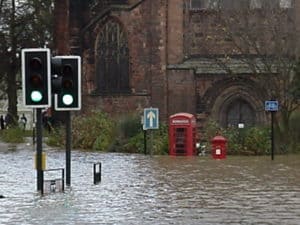Tips for reducing flood risks for homeowners
It was recently revealed that the UK government is set to plan for 20-30% more extreme downpours than it ever has done before, after being criticised for its response to flooding across the country over the past few years.
With the government expecting more flooding to take place across the UK, what can homeowners do to reduce the risk of damage to their property?
While solutions and defences implemented by the government, councils and other, larger organisations have the biggest impact on flood defence, there are certainly things you can do personally to reduce the risk of flooding in your property.
Here are our top ten tips for UK homeowners worried about flooding:
1.Ensure surface water drains are clean and clear of silt and debris
Simply put, surface water refers to rainwater that falls anywhere on your property, from your roof to your paths. This is typically removed from a property and into a public sewer by a network of drains and gullies.
However, silt and debris, such as leaves or moss, can block these drains and cause water to build up further.
2. Don’t pour fat down your drains
Fat is one of the ‘dirty dozen’ items that absolutely should not be poured into the drain. It congeals in the drains and reduces water flow, which causes problems when you need full bore flow on drains and sewers at times of heavy rainfall.
3. Make sure that there is good ‘fall’ on drains and pipes
The ‘fall’ of a drainage pipe refers to the distance between the highest point of the pipe and the floor. In other words it helps us work out the gradient, or steepness, of the pipe, to ensure water can flow away very quickly. A professional can help you ensure the fall and gradient of your pipes are correct. Getting it wrong could mean water does not flow quickly enough, but could also lead to solids getting stuck in the pipes and causing blockages.
4. Keep an eye on flood maps
The Environment Agency operates a very detailed flood map, which displays the latest flood warnings, as well as the level of flood risk in your area. Friends of the Earth offers another easy-to-use flood map. These resources can help you better plan for floods before they happen.
5. Make use of Floodline
Floodline Warnings Direct is a free service from the Environment Agency that provides flood warnings by phone, text or email. Find out if you are eligible to sign up for the service by calling 0345 988 1188.
6. Understand the difference between flood ‘alerts’ and flood ‘warnings’
- Flood alerts mean flooding is possible, so be prepared
- Flood warnings mean flooding is expected and that immediate action is required
7. Understand your insurance policy
Do you know the level of cover granted to you by your contents and buildings insurance policies? If not, check your policy and make sure you are covered for flooding and what you are expected to do, from an insurance perspective, in the event of a flood.
8. Prepare a flood kit
The Environment Agency states that essential items to be included in a flood kit and kept handy in case of flooding should include:
- A first aid kit and prescription medication
- Copies of your home insurance documents
- A wind-up or battery radio
- A torch with spare batteries
- Bottled water and non-perishable foods
- Warm, waterproof clothing
- Blankets
- Baby food
9. Know how to turn off your gas, electricity and water mains supplies
If flood water is about to enter your home, it’s important to turn off the gas, electricity and water supplies as soon as possible, if it’s safe to do so. Find out in advance how to do this by contacting your provider and make a note of the steps so you can do it quickly when the circumstances arise.
10. Invest in temporary flood protection equipment
You may not ever need it but temporary flood protection equipment such as floodboards and sandbags can help to protect your property. While sandbags are often provided by councils, sometimes they run out, so it may be worth investing in your own, or alternatives to traditional sandbags such as FloodSax.
Find out how to use sandbags properly.

